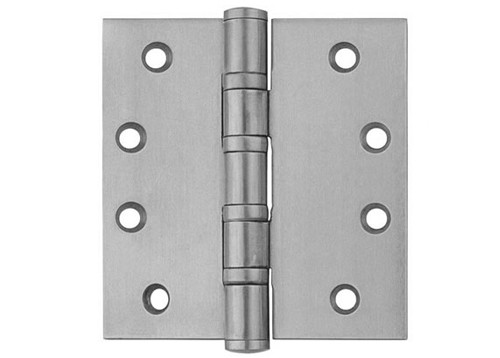PHOTO: Door hinges
Door hinges, often overlooked and underestimated, are essential components of our daily lives. They serve a crucial purpose, enabling the movement of doors that we use countless times each day. While their function might seem straightforward, the world of door hinges is a labyrinth of designs, materials, and applications that can leave one in awe. In this article, we will delve into the intricate world of door hinges, uncovering their history, various types, materials, and the ingenious mechanisms that make them indispensable.
The Historical Evolution
Door hinges have a history that stretches back thousands of years. The earliest hinges, dating back to ancient Mesopotamia, were made of wood and stone. They were basic in design but served their purpose of allowing doors to swing open and shut. Over time, door hinges evolved along with human civilization. In ancient Egypt, they were crafted from bronze and had ornate designs, showcasing their importance in both function and aesthetics.
The Industrial Revolution brought a significant shift in the manufacturing of hinges. With the advent of mass production, hinges became more accessible to the general population. This era saw the rise of butt hinges, one of the most common types of hinges today. They are flat and rectangular, with screw holes to attach them to the door and the door frame. This evolution marked the transition from artisanal craftsmanship to standardized manufacturing processes.
Modern Hinge Varieties
Today, the diversity of door hinge designs is staggering. Each type serves a unique purpose, adapted to different applications and architectural styles. Let’s explore some of the most common hinge varieties:
- Butt Hinges: As mentioned earlier, butt hinges are a staple in door hinge design. They are typically used for interior doors and cabinets, providing a simple yet effective pivot mechanism.
- Continuous Hinges: Also known as piano hinges, these are long, thin strips that run the entire length of a door or panel. They are often used in commercial applications, providing durability and even weight distribution.
- Pivot Hinges: Pivot hinges enable doors to rotate a full 360 degrees. These are commonly found in restaurant and bar doors, allowing for smooth and dramatic entries and exits.
- European Hinges: These hinges are commonly used for cabinet doors and offer adjustable features that allow for precise alignment and effortless operation.
- Ball Bearing Hinges: Designed for heavy-duty doors, ball bearing hinges use ball bearings to reduce friction, making them ideal for high-traffic areas.
- Concealed Hinges: Popular in modern interior design, concealed hinges are hidden within the door and frame, providing a sleek, minimalist appearance.
THE ANCIENT STONE CITY: Proof of NZ civilisation before Kupe
Materials Matter
The materials used to craft door hinges play a significant role in their functionality and longevity. Here’s a look at some of the most common materials used in hinge production:
- Steel: Steel hinges are renowned for their strength and durability. They are suitable for heavy doors and high-traffic areas.
- Brass: Brass hinges are not only durable but also corrosion-resistant. They are often chosen for their aesthetic appeal in homes and commercial spaces.
- Stainless Steel: These hinges are prized for their resistance to rust and corrosion, making them ideal for outdoor applications and areas with high humidity.
- Zinc: Zinc hinges are an economical choice and are commonly used in residential applications.
- Bronze: Bronze hinges are known for their timeless elegance and are a popular choice for ornate doors.
- Plastic: Plastic hinges are often used for lightweight doors and cabinets. They offer a cost-effective solution for less demanding applications.
2023 PRICING: Profile YOU on this website! – FOR 12 MONTHS | ONLY $999 plus GST
Ingenious Hinge Mechanisms
Beyond materials and design, the mechanics behind door hinges are a testament to human ingenuity. Various hinge mechanisms are engineered to meet specific needs:
- Friction Hinges: These hinges use friction to hold a door in position at different angles. They are commonly found in laptops and adjustable cabinet doors.
- Spring Hinges: Spring-loaded hinges automatically close a door after it has been opened. These are useful in commercial settings where self-closing doors are necessary.
- Self-Closing Hinges: These hinges are equipped with a mechanism that gently closes the door without the need for additional hardware. They are often used in kitchen cabinets.
- Cam Hinges: Cam hinges allow doors to swing open while also lifting, making them ideal for cabinet doors and access panels.
- Detent Hinges: Detent hinges have multiple fixed positions, allowing doors to stay in specific open angles. They are widely used in furniture design.
Two individuals have been sentenced to prison in connection with an $8.7 million mortgage fraud case
Conclusion
Door hinges, those unassuming mechanical marvels, are indeed the unsung heroes of our daily lives. They have a long and diverse history, come in a wide array of designs, and are crafted from an assortment of materials. Their ingenious mechanisms cater to various needs, making them indispensable in our homes, offices, and beyond. So, the next time you open a door, take a moment to appreciate the intricate world of door hinges that makes it all possible. From ancient times to the modern era, these unsung heroes continue to shape our world, one pivot at a time.
















